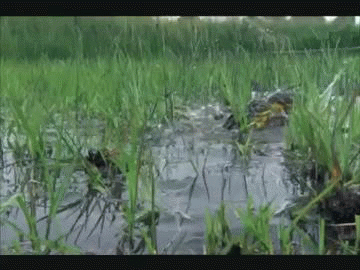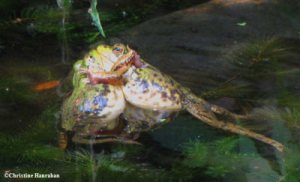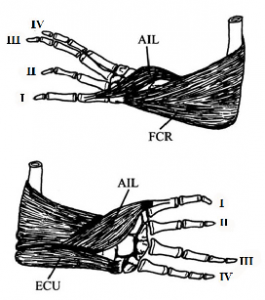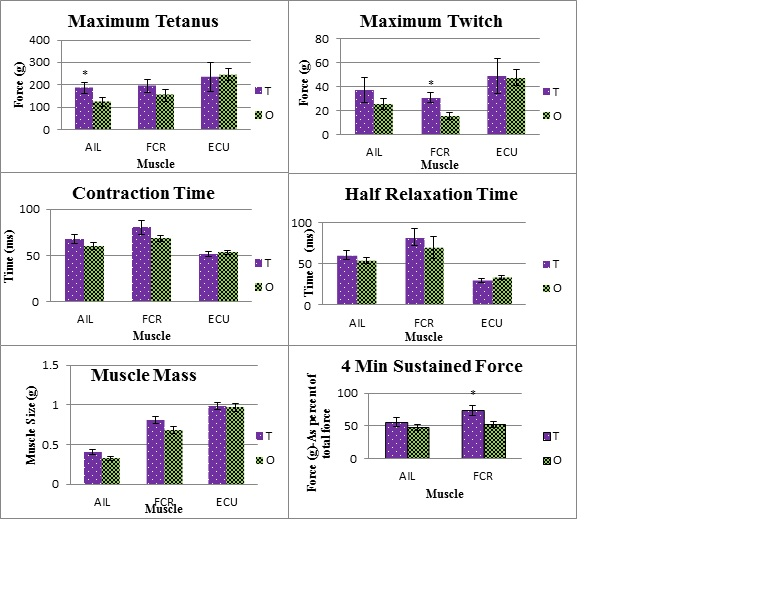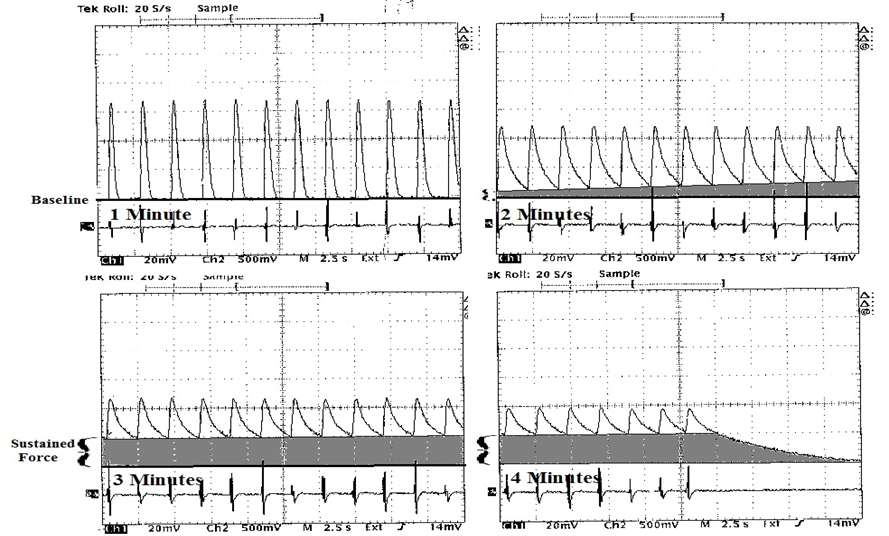(A very brief overview of the study, more information available upon request).
Grappling
With the increase in popularity of mixed martial arts grappling has become an increasingly popular sport . But did you know many animals also grapple? Many times they do so to attract the attention of females or to procure rights to a mating territory or mate. Bullfrogs are great grapplers and they fight for their territory.
You can see from the picture above that frogs are aggressive grapplers! You can also see they use mainly their forelimbs (specifically their flexor carpi radialis muscle, FCR) and thumbs (controlled by the abductor indicus longus, AIL) to thrust each other out of a disputed territory. The extensor carpi ulnaris is a muscle that is not involved in these behaviors and it is simply used as a control in my study.
The benefits of this observation allowed me to focus in on a few characteristics in particular. First, how are muscles specifically adapted for such a behavior and secondly, what physiological factors affect or do not affect these adaptations.
Why bullfrogs?
Often times scientists are asked why they do not study a particular trait or the effects of trait manipulation on humans. As you might imagine manipulating humans is costly and dangerous in certain experiments. This and the difficulty of establishing controls is why animal models are often used for scientific studies. Moreover, testosterone is constantly released in adult males Homo sapiens. Bullfrogs release testosterone cyclically and have evolved specialized musculature that is affected by hormonal release. Hence, it serves as a perfect model for studying the physiological effects of testosterone on muscle tissue in vertebrates. Lastly, any discoveries in relation to amphibians (an extremely sensitive class of animals) aids in the education and conservation of these animals suffering from increasingly polluted environments.
Mating Season
Bullfrogs most often mate in large ponds where they set up and defend territories scattered throughout the pond. Males congregate in large groups to compete for mates by calling towards one another and towards females. The procurement of oviposition sites (this is where females lay their eggs) is the main force driving the organization and distribution of males, since females almost always lay their eggs in the male’s territory. Dominant males who have the largest territories stake claim to the central location of these breeding aggregations. As competition involves calling for mates and threat displays towards competing males, fighting between males often ensues. This is when the grappling begins!
Testosterone
Anyone who’s ever seen a body building competition knows the importance of how increased testosterone affects muscle size. However, it can also affect a multitude of other characteristics. Which ones you say? First, it’s important to know why bullfrogs make such a great model organism for this type of study. With the onset of the new breeding season androgen levels increase with an increase in chorusing (this is when males call towards competing males as if to say “bring it on buddy” and when they call towards females as if to say “hey pretty lady”). Therefore, testosterone rises when breeding season begins and falls as it ends. This allowed me to study the effects of testosterone on specially adapted muscles in both a non-breeding (essentially testosterone-less) and breeding (testosterone-full) condition.
What else can you do with those guns?
Not only do bullfrogs use their forelimbs for grappling but they also use them for amplexus. Amplexus is the mating embrace frogs use for mating.Once a female is attracted to a particular male and his territory, males use this mating embrace to grasp females from behind, clinging to the “waist” or axillary region thereby stimulating the female until she releases her eggs . Amplexus lasts approximately two hours on average in bullfrogs but some species maintain this posture for up to a week. Imagine holding a pullup for hours on end!
What we know
It has long been known that the wrist, elbow and shoulder flexor muscles are differentially enlarged in male frogs to facilitate amplexus. Previous studies document sex differences in mass and energy stores and in fiber types and sizes. Most recently, several studies have shown that these male forelimb muscles exhibit significantly larger isometric forces and longer twitch contraction (CT) and half-relaxation (½ RT) times than females ( Moreover, previous research in Dr. Peter’s lab discovered that in bullfrogs the prolonged relaxation times allow male muscles to sustain force with little decrease for long periods (>2 sec) between stimuli, resulting in reduced fatigability. This ability may be a key feature in minimizing energy expenditure during prolonged periods of amplexus. The same results have been documented in the marine toad (Bufo marinus), the European common frog (Rana temporaria) and the Japanese brown frog , suggesting that slow relaxation and sustained force may be synapomorphic features among anurans.
My Project
So we know male frog muscles involved in these behaviors are stronger and less fatigable right? We also know that testosterone increases in the breeding season right? So in my project I wanted to investigate the effects of testosterone on the same characteristics (force production and fatigability) compared between males and females. So what did I do? I castrated a group of male bullfrogs all in nonbreeding condition. In half of them I replaced the testosterone with implants (to simulate breeding condition) and the other half simply received empty implants.
How does testosterone affect these muscles?
Remarkably, it seems that testosterone only affects certain muscle properties and not others! For example, twitch force (which involves stimulating a muscle for a brief period) was higher in the FCR of testosterone treated individuals while tetanic force (stimulating the muscle at a maximal level) was significantly higher in the AIL of testosterone treated individuals. Sustained force (the force sustained throughout long periods of stimulation) was also higher in the FCR of testosterone treated individuals. Some characteristics such as contraction and half relaxation times do not seem to be affected by testosterone treatment.
What Isn’t Affected by Testosterone?
Characteristics associated with fatigability and endurance of these muscles either seem to be only slightly affected or not affected at all by testosterone. For example, look at the following electromyogram (a tracing of muscle force on an oscilloscope):
Sustained force development during the fatigue test is shown for a representative testosterone treated individual’s abuductor indicus longus, AIL; Fig2. Force produced is shown in the top trace and the EMG trace is shown below. During the first minute, the brief tetanic bursts (force production) rise and fall back to baseline. By 2 min, the relaxation times have elongated the trailing off of the force traces and they fail to return to baseline during the 2 sec between stimulus trains. The shaded area shows the amount of unrelaxed force (sustained force) as it increases throughout 3 min and 4 min. By the end of the test over half of the total force is sustained force, and at the end it takes nearly 10 seconds for the muscle to relax back down to the original baseline. (stimulation at 30 pps for 200 msec, 1 every 2sec; sweep speed = 2.5 sec). This phenomenon is amazing and was first documented (in my lab with Dr. Sue Peters at UNCC). This means that as time proceeds during a fatigue test the muscle doesn’t relax in between stimulations. As you might imagine this is extremely energetically efficient as it occurs independent of testosterone treatment. Imagine being able to hold a pullup position for hours!
What does all this mean?
Well to be as specific as possible it means that testosterone affects certain muscle properties but not others-in American Bullfrogs. It seems to increase the overall force generation these muscles are capable of but either does not or only slightly increases their endurance capabilities. That’s it. Of course, extrapolations can be made in many directions but much more research is necessary to investigate what genetic and cellular mechanisms are at play affecting these specific properties. These include the expression of calcium transporters in myofibrils (muscle cells) and the exact architecture of myosin and actin filaments in these muscles as well.
Remember, often times journalists write articles based on scientific findings via online media citing studies they claim are relevant. No studies have been conducted that test the manipulation of testosterone and its effects on muscle function in humans. It simply isn’t practical. So, the next time you read on yahoo news about what this performance enhancer or that dietary supplement does, make sure you check the source. What they found may have been in Chipmunks, not people : )
